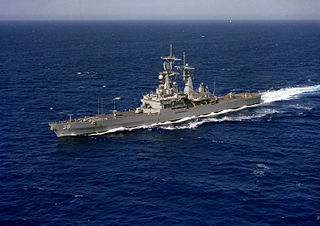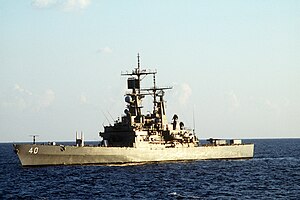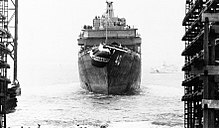
USS Texas (DLGN/CGN-39) was the United States Navy's second Virginia-class nuclear guided missile cruiser. She was the third ship of the Navy to be named in honor of the State of Texas. Her keel was laid down on 18 August 1973, at Newport News, Virginia, by the Newport News Shipbuilding and Drydock Company.

USS Virginia (CGN-38) was a nuclear-powered guided missile cruiser, the lead ship of her class, and the eighth ship of the United States Navy to be named for the Commonwealth of Virginia. She was commissioned in 1976 and decommissioned in 1994.

USS Dwight D. Eisenhower (CVN-69) is a nuclear-powered aircraft carrier currently in service with the United States Navy. Commissioned in 1977, the ship is the second of ten Nimitz-class aircraft carriers currently in service, and is the first ship named after the 34th President of the United States and General of the Army, Dwight D. Eisenhower. The vessel was initially named simply as USS Eisenhower, much like the lead ship of the class, Nimitz, but the name was changed to its present form on 25 May 1970. The carrier, like all others of her class, was constructed at Newport News Shipbuilding Company in Virginia, with the same design as the lead ship, although the ship has been overhauled twice to bring her up to the standards of those constructed more recently.

USS Enterprise (CVN-65), formerly CVA(N)-65, is a decommissioned United States Navy aircraft carrier. In 1958, she was the first nuclear-powered aircraft carrier and the eighth United States naval vessel to bear the name. Like her predecessor of World War II fame, she is nicknamed "Big E". At 1,123 feet (342 m), she is the longest naval vessel ever built and the only ship of a class that was originally planned to have five other ships. Her 93,284-long-ton (94,781 t) displacement ranks her class as the third largest carrier class, after the Nimitz class and the Gerald R. Ford class. Enterprise had a crew of some 4,600 service members.

The fifth USS Truxtun (DLGN-35/CGN-35) was a nuclear powered cruiser in the U.S. Navy. She was launched as a destroyer leader and later reclassified as a cruiser. She was named after Commodore Thomas Truxtun (1755–1822). She was in service from May 1967 to September 1995.

Carrier Strike Group 9 is a U.S. Navy carrier strike group. Commander Carrier Strike Group 9 is responsible for unit-level training, integrated training, and material readiness for the ships and aviation squadrons assigned to the group. The group reports to Commander, U.S. Third Fleet, which also supervises its pre-deployment training and certification that includes Composite Unit Training Exercises.

USS Long Beach (CLGN-160/CGN-160/CGN-9) was a nuclear-powered guided missile cruiser in the United States Navy and the world's first nuclear-powered surface combatant. She was the third Navy ship named after the city of Long Beach, California.

USS Arkansas (CGN-41) was a Virginia-class nuclear-propelled guided-missile cruiser of the U.S. Navy. She was in commission from October 1980 through July 1998. Her primary missions were in defending aircraft carrier task forces in air defense (AAW) and antisubmarine warfare (ASW) by using her guided missiles, radar systems, and sonar systems. Since Arkansas had the high speed and unlimited range provided by her nuclear reactors, she usually escorted the nuclear-powered aircraft carriers of the U.S. Navy.

USS Cheyenne (SSN-773), the final Los Angeles-class submarine, is the third ship of the United States Navy to be named for Cheyenne, Wyoming. The contract to build her was awarded to Newport News Shipbuilding and Dry Dock Company in Newport News, Virginia on 28 November 1989 and her keel was laid down on 6 July 1992. She was launched on 16 April 1995 sponsored by Mrs. Ann Simpson, wife of Wyoming Senator Alan K. Simpson, and commissioned on 13 September 1996, with Commander Peter H. Ozimik in command. Cheyenne transferred to her homeport of Pearl Harbor, Hawaii, in 1998.

USS Bainbridge (DLGN-25/CGN-25) was a nuclear-powered guided missile cruiser in the United States Navy, the only ship of her class. Named in honor of Commodore William Bainbridge, she was the fourth US Navy ship to bear the name. With her original hull classification symbol of DLGN, she was the first nuclear-powered destroyer-type ship in the US Navy, and shared her name with the lead ship of the first US Navy destroyer class, the Bainbridge-class destroyers.

USS Bunker Hill (CG-52) was a Ticonderoga-class guided missile cruiser of the United States Navy constructed by Litton-Ingalls Shipbuilding Corporation at Pascagoula, Mississippi and launched on 11 March 1985. The Ticonderoga-class cruisers are equipped with the Aegis Combat System and Bunker Hill is the first of the class to be equipped with the Mark 41 Vertical Launching System (VLS) in place of the previous ships' twin-arm Mark 26 missile launchers, which greatly improved the flexibility and firepower of the ships by allowing them to fire BGM-109 Tomahawk cruise missiles for land attack missions. Other missions include ballistic missile defence and capital ship escort for anti-aircraft defense. The ship was commissioned on 20 September 1986 and was homeported at Naval Base San Diego in San Diego, California.

The Spruance-class destroyer was developed by the United States to replace the many World War II–built Allen M. Sumner- and Gearing-class destroyers, and was the primary destroyer built for the United States Navy during the 1970s and 1980s. It was named in honor of U.S. Navy Admiral Raymond A. Spruance, who successfully led major naval battles in the Asiatic-Pacific Theater during World War II such as the Battle of Midway and the Battle of the Philippine Sea.

USS Barry (DDG-52) is an Arleigh Burke-class guided missile destroyer, commissioned in 1992. Barry is the fourth United States Navy ship named after the "Father of the American Navy", Commodore John Barry (1745–1803). Her homeport is Naval Station Everett, Washington. Several improvements over Arleigh Burke exist on this ship and all following Arleigh Burke-class destroyers, such as the ability to refuel a helicopter.

The Virginia class were four nuclear-powered, guided-missile cruisers that served in the United States Navy until the mid-to-late 1990s. The double-ended cruisers were commissioned between 1976 and 1980. They were the final class of nuclear-powered cruisers completed and the last ships ordered as Destroyer Leaders under the pre-1975 classification system.

USS Normandy (CG-60) is a Ticonderoga-class guided-missile cruiser in the service of the United States Navy. Armed with naval guns and anti-air, anti-surface, and anti-submarine missiles, plus other weapons, she is equipped for surface-to-air, surface-to-surface, and anti-submarine warfare. The cruiser was the first US warship since 1945 to go to war on her maiden cruise, and in 1998 was awarded the title "Most Tomahawks shot by a U.S. Navy Cruiser". She is named for the World War II Battle of Normandy, which took place in France on, and following, D-Day.

USS South Carolina (CGN-37) was the second ship of the California class of nuclear-powered guided missile cruisers in the United States Navy.
The names of commissioned ships of the United States Navy all start with USS, for United States Ship. Non-commissioned, primarily civilian-crewed vessels of the U.S. Navy under the Military Sealift Command have names that begin with USNS, standing for United States Naval Ship. A letter-based hull classification symbol is used to designate a vessel's type. The names of ships are selected by the Secretary of the Navy. The names are those of states, cities, towns, important persons, important locations, famous battles, fish, and ideals. Usually, different types of ships have names originated from different types of sources.

USS California (CGN-36), the lead ship of the California-class of nuclear-powered guided missile cruisers, was the sixth warship of the United States Navy to be named for the state of California. She was the last active nuclear-powered cruiser for the United States.

A carrier strike group (CSG) is a type of carrier battle group of the United States Navy. It is an operational formation composed of roughly 7,500 personnel, usually an aircraft carrier, at least one cruiser, a destroyer squadron of at least two destroyers or frigates, and a carrier air wing of 65 to 70 aircraft. A carrier strike group also, on occasion, includes submarines, attached logistics ships and a supply ship. The carrier strike group commander operationally reports to the commander of the numbered fleet, who is operationally responsible for the area of waters in which the carrier strike group is operating.
United States ship naming conventions for the U.S. Navy were established by congressional action at least as early as 1862. Title 13, section 1531, of the U.S. Code, enacted in that year, reads, in part,
The vessels of the Navy shall be named by the Secretary of the Navy under direction of the President according to the following rule: Sailing-vessels of the first class shall be named after the States of the Union, those of the second class after the rivers, those of the third class after the principal cities and towns and those of the fourth class as the President may direct.


























